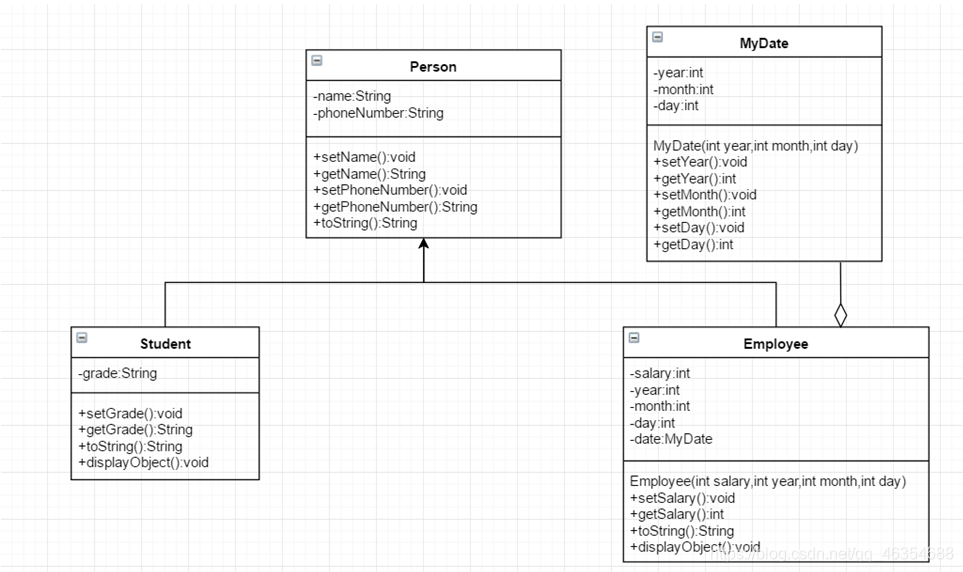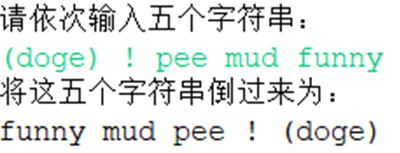第一题
【Person、Student、Employee类】(注:此题在书上原题基础上有修改)设计一个名为Person的类和它的两个名为Student和Employee子类。
每个人都有姓名和电话号码。学生有年级状态(大一、大二、大三或大四)。将这些状态定义为常量。一个雇员有工资和受聘日期。定义一个名为MyDate的类,包含数据域:year(年)、month(月)和day(日)。将各个类的数据域进行封装,并设置合理的读写访问器。
覆盖每个类中的toString方法,返回类名及相应的类中可以获取的所有信息构成的字符串,如Person类的toString方法返回“Person类:姓名为*** 电话为***”;Student类的toString方法返回“Student类: 姓名为*** 电话为*** 年级为***”。
在Student和Employee两个类中分别加入displayObject()方法,可以打印出对学生和雇员的提示消息,提示学生“to ***(学生姓名):请按时交实验报告”,提示雇员“to ***(雇员姓名):请按时上班”。
目标输出任务:
- 画出这些类的UML图。
- 实现这些类。
- 编写一个测试类,
1)创建方法public static void m1(Person p),显示p的姓名;
2)创建方法public static void m2(Person p),打印p的toString方法返回的字符串;
3)创建方法public static void m3(Person p),如果p是Student类或者Employee类的实例,分别调用它们的displayObject();
4)在主函数中创建Person、Student、Employee的对象实例,将它们均声明为Person类对象。将它们分别传入m1、m2和m3,体会多态。
(1)UML图:

(2)运行结果

(3)结果分析
对每个对象依次调用m1,m2,m3方法,依次打印出对象的名字和toString方法,对于student类和Employee类还会打印出displayObject方法。
(4)心得体会
代码量真的多,难度不大但是很繁琐。本题除了主函数所在的Program1类外还有四个类,每个类的定义与实现都是一个需要花时间的过程。
(5)源代码
Person类:
package 实验5;
public class Person {
//私有数据域
private String name;
private String phoneNumber;
//修改器和访问器
public void setName(String name){
this.name = name;
}
public String getName(){
return name;
}
public void setPhoneNumber(String phoneNumber){
this.phoneNumber = phoneNumber;
}
public String getPhoneNumber(){
return phoneNumber;
}
//方法重写
public String toString(){
return "Person类: 姓名为:"+name+" 电话号码为: "+phoneNumber;
}
}
Student类:
package 实验5;
public class Student extends Person {
public final static String grade1 = "大一";
public final static String grade2 = "大二";
public final static String grade3 = "大三";
public final static String grade4 = "大四";
//私有数据域
private static String grade;
//构造函数
Student(String grade){
this.grade = grade;
}
//修改器与访问器
public void setGrade(String grade){
this.grade = grade;
}
public String getGrade(){
return grade;
}
//方法重写
public String toString(){
return "Student类: 姓名为:"+getName()+" 电话号码为: "+getPhoneNumber()+" 年级为: "+grade;
}
//提示信息
public void displayObject(){
System.out.println("to"+getName()+":请按时交实验报告");
}
}
Employee类:
package 实验5;
public class Employee extends Person{
//私有数据域
private int salary;
private int year;
private int month;
private int day;
private MyDate date;
//构造函数
Employee(int salary,int year,int month,int day){
this.salary = salary;
this.year = year;
this.month = month;
this.day = day;
date = new MyDate(year,month,day);
}
//修改器与访问器
public void setSalary(int salary){
this.salary = salary;
}
public int getSalary(){
return salary;
}
//方法重写
public String toString(){
return "Employee类: 姓名为:"+getName()+" 电话号码为: "+getPhoneNumber()+" 工资为 "+salary+" 受聘日期为: "+date.toString();
}
//提示信息
public void displayObject(){
System.out.println("to"+getName()+":请按时上班");
}
}
MyDate类:
package 实验5;
public class MyDate {
//私有数据域
private int year;
private int month;
private int day;
//构造函数
MyDate(int year,int month,int day){
this.year = year;
this.month = month;
this.day = day;
}
//修改器与访问器
public void setYear(int year){
this.year = year;
}
public int getYear(){
return year;
}
public void setMonth(int month){
this.month = month;
}
public int getMonth(){
return month;
}
public void setDay(int day){
this.day = day;
}
public int getDay(){
return day;
}
//方法重写
public String toString(){
return year+"年"+month+"月"+day+"日";
}
}
Program1:
package 实验5;
public class Program1 {
public final static String grade1 = "大一";
public final static String grade2 = "大二";
public final static String grade3 = "大三";
public final static String grade4 = "大四";
public static void m1(Person p){
System.out.println(p.getName());
}
public static void m2(Person p){
System.out.println(p.toString());
}
public static void m3(Person p){
if(p instanceof Student){
((Student) p).displayObject();
}
else if(p instanceof Employee){
((Employee) p).displayObject();
}
}
public static void main(String[] args) {
Person person = new Person();
person.setName("张三");
person.setPhoneNumber("13694562696");
Person student = new Student(grade1);
student.setName("李四");
student.setPhoneNumber("13745659693");
Person employee = new Employee(10000, 2012, 10, 20);
employee.setName("王五");
employee.setPhoneNumber("13974569636");
m1(person);
m2(person);
m3(person);
m1(student);
m2(student);
m3(student);
m1(employee);
m2(employee);
m3(employee);
}
}
第二题
【课程类Course】改写程序清单10-6中的Course类。 使用ArrayList代替数组来存储学生。不应该改变Course类的原始合约(即不要改变构造方法和方法的方法头定义,包括返回类型、方法名及参数列表,但私有的成员可以改变)。
程序清单10-6:
public class Course {
private String courseName;
private String[] students = new String[100];
private int numberOfStudents;
public Course(String courseName) {
this.courseName = courseName;
}
public void addStudent(String student) {
students[numberOfStudents] = student;
numberOfStudents++;
}
public String[] getStudents() {
return students;
}
public int getNumberOfStudents() {
return numberOfStudents;
}
public String getCourseName() {
return courseName;
}
public void dropStudent(String student) {
// Left as an exercise in Exercise 9.9
}
}
程序清单10-5
【注意:请参考以下程序来测试Course类,同时注意在此段程序基础上,增加必要的代码,以完整地测试Course类中定义的所有方法】
public class TestCourse {
public static void main(String[] args) {
Course course1 = new Course("Data Structures");
Course course2 = new Course("Database Systems");
course1.addStudent("Peter Jones");
course1.addStudent("Brian Smith");
course1.addStudent("Anne Kennedy");
course2.addStudent("Peter Jones");
course2.addStudent("Steve Smith");
System.out.println("Number of students in course1: "
+ course1.getNumberOfStudents());
String[] students = course1.getStudents();
for (int i = 0; i < course1.getNumberOfStudents(); i++)
System.out.print(students[i] + ", ");
System.out.println();
System.out.print("Number of students in course2: "
+ course2.getNumberOfStudents());
}
}
(1)运行结果

(2)结果分析
此结果在原有的基础上增加了对getName方法和dropStudent方法的测试,执行dropStudent(“Peter Jones”)后,学生个数少了一个,学生列表里也少了Peter Jones。
(3)心得体会
直接在源代码上修改,使工程量减少了很多。直接用ArrayList类中的remove方法比数组中删除元素更加快捷。
(4)源代码
Course类:
package 实验5;
import java.util.ArrayList;
public class Course {
private String courseName;
ArrayList<String> students = new ArrayList<>();
private int numberOfStudents;
public Course(String courseName) {
this.courseName = courseName;
}
public void addStudent(String student) {
students.add(student);
numberOfStudents++;
}
public ArrayList<String> getStudents() {
return students;
}
public int getNumberOfStudents() {
return numberOfStudents;
}
public String getCourseName() {
return courseName;
}
public void dropStudent(String student) {
for(int i=0;i<numberOfStudents;i++){
if(students.get(i).equals(student)){
students.remove(i);
numberOfStudents--;
}
}
}
}
TestCourse类:
TestCourse类:
package 实验5;
import java.util.ArrayList;
public class TestCourse {
public static void main(String[] args) {
Course course1 = new Course("Data Structures");
Course course2 = new Course("Database Systems");
course1.addStudent("Peter Jones");
course1.addStudent("Brian Smith");
course1.addStudent("Anne Kennedy");
course2.addStudent("Peter Jones");
course2.addStudent("Steve Smith");
System.out.println("Name of course1 is: "+ course2.getCourseName());
System.out.println("Before dropping the student 'Peter Jones',the number of students in course1: "+ course1.getNumberOfStudents());
ArrayList<String> students = course1.getStudents();
for (int i = 0; i < course1.getNumberOfStudents(); i++)
System.out.print(students.get(i) + ", ");
System.out.println();
course1.dropStudent("Peter Jones");
System.out.println("After dropping the student 'Peter Jones',the number of students in course1: "+ course1.getNumberOfStudents());
for (int i = 0; i < course1.getNumberOfStudents(); i++)
System.out.print(students.get(i) + ", ");
System.out.println();
System.out.println("Name of course2 is: "+ course2.getCourseName());
System.out.println("Number of students in course2: "+ course2.getNumberOfStudents());
}
}
第三题
(利用继承实现MyStack)在程序清单11-10中,MyStack是用组合实现的。扩展ArrayList创建一个新的栈类。实现MyStack类。编写一个测试程序,提示用户输入5个字符串,然后以逆序显示这些字符串。
(1)运行结果

(2)结果分析
将五串字符倒过来就是结果
(3)心得体会
弄懂题目意思花了我最长时间。一开始用ArrayList继承Stack,然后开始套娃,不知道这样做的意义。后面认真读题才发现是MyStack继承ArrayList,这道题有难度。
(4)源代码
MyStack 类:
package 实验5;
import java.util.ArrayList;
public class MyStack extends ArrayList{
public Object pop(){
Object o = get(this.size()-1);
this.remove(this.size()-1);
return o;
}
public void push(Object o){
this.add(o);
}
public boolean isEmpty(){
if(this.size()==0) return true;
return false;
}
Program3:
package 实验5;
import java.util.Scanner;
public class Program3 {
public static void main(String[] args) {
MyStack s = new MyStack();
Scanner input = new Scanner(System.in);
System.out.println("请依次输入五个字符串:");
for(int i=0;i<5;i++){
s.push(input.next());
}
System.out.println("将这五个字符串倒过来为:");
while(!s.isEmpty()){
System.out.print(s.pop()+" ");
}
}
}






















 510
510











 被折叠的 条评论
为什么被折叠?
被折叠的 条评论
为什么被折叠?








